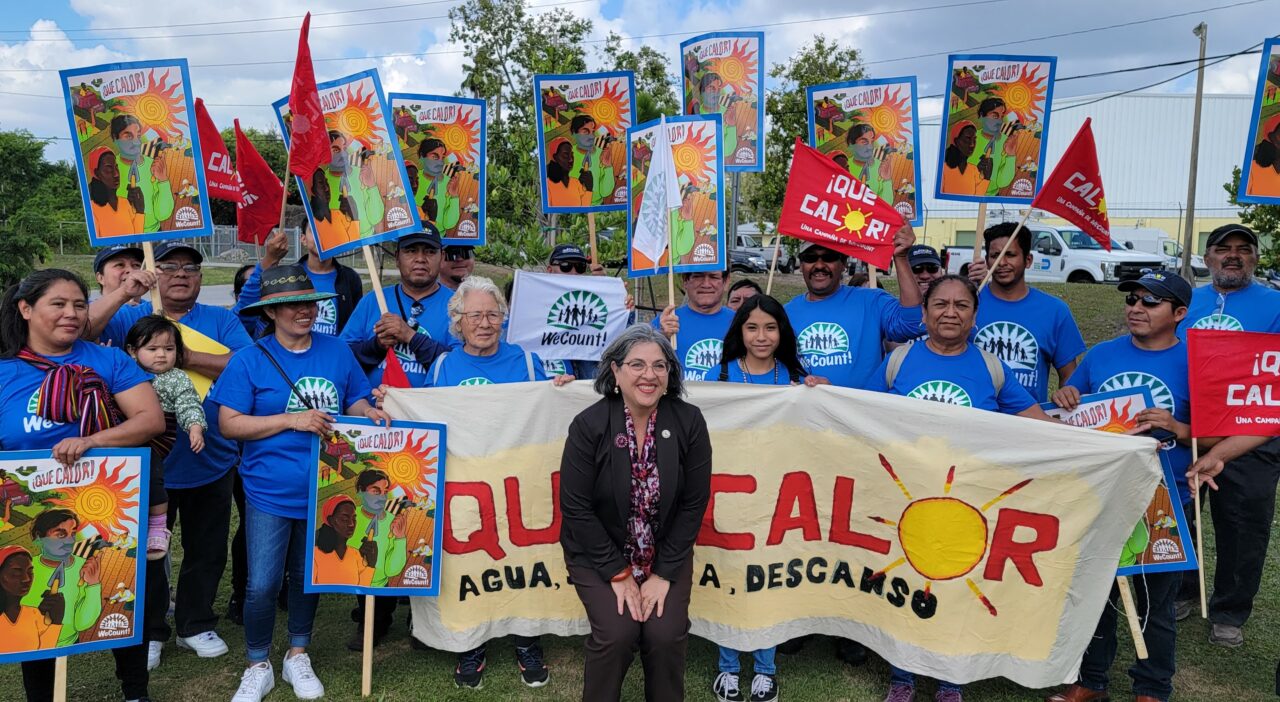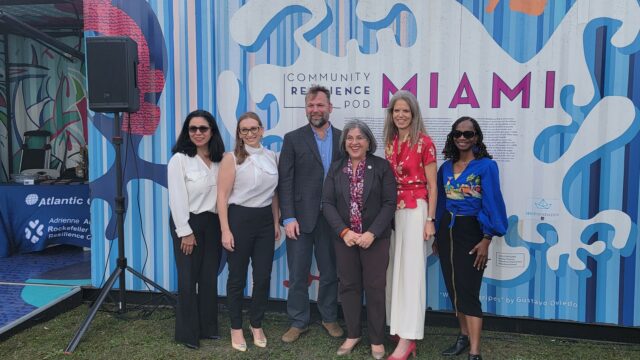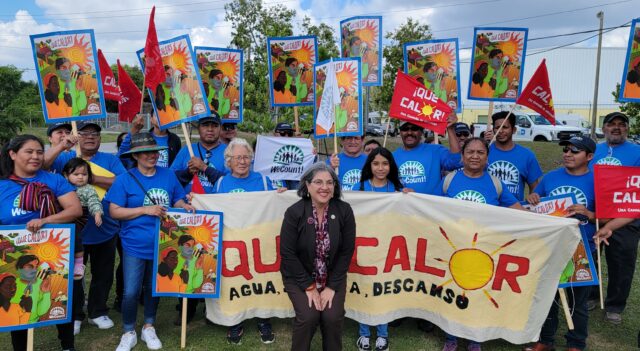- air conditioning
- Andres Villegas
- Baptist Health
- Cheryl Holder
- Chief Heat Officer
- Climate and Heat Health Task Force
- Danielle Cohen Higgins
- extreme heat
- Extreme Heat Action Plan
- HB 887
- Heat index
- Jane Gilbert
- Kurt Shickman
- Maria Nardi
- miami dade county
- Miami-Dade
- National Climate Risk Assessment
- Occupational Safety and Health Administration
- Office of Resilience
- OSHA
- Planting trees
- Que Calor
- SB 732
- Tree planting
- trees
- Vivid Economics
- Weather Assistance Program
- WeCount!

Miami-Dade has long been known for its heat. Tourism publicity photos from the 1960s depict beachgoers enjoying the sun and no shortage of convertibles taking in the county’s balmy weather.
When the owners of a new basketball franchise ran a name-the-team contest in 1986, the response from Miami residents was appropriately warm. Locals submitted thousands of recommendations like the “Beaches” and the “Suntans.” The owners went with the more on-the-nose “Heat.”
But ask any local today and they’ll likely say the sweltering climate is often unbearable, particularly during what feels like an endless summer. That’s not recency bias. In the ’60s, roughly 85 days out of the year in Miami-Dade had temperatures over 90 degrees, according to the county’s Office of Resilience. Today, it’s about 133 days.
Then there’s extreme heat, which the U.S. government defines as a period of high heat and humidity with temperatures above 90 degrees for at least two to three days. During such blistering periods, the human body fights to maintain normal temperatures, which can lead to adverse health effects, including death.
In fact, extreme heat kills more people annually — especially older adults, children and sick or overweight individuals — than any other weather-related hazard.
Miami-Dade experienced 31 consecutive days in 2020 where the heat index reached or exceeded 100 degrees. People got sick. Every year, about 34 people die from heat-related illness. Many others already contending with exorbitant housing costs saw their utility bills skyrocket.
Unless something changes, Miamians could suffer through 91 straight days of 100-degree temperatures or higher by 2053, according to projections by the First Street Foundation’s National Climate Risk Assessment, and cooler times will still be hot relative to current temperatures.
That’s a troubling prospect Miami-Dade leaders hope to avoid. At a Wednesday news conference in Hialeah, they unveiled the Extreme Heat Action Plan to address the issue.
“Here in Miami-Dade, we are at increased risk from sea level rise and intensifying weather events like storms and hurricanes .… But as the temperature rises, we must also work to address the silent killer, extreme heat. It threatens both our community’s health and our economic prosperity,” Mayor Daniella Levine Cava told attendees at Amelia Earhart Park.
“With this Extreme Heat Action Plan, we are moving from ambition into execution and encouraging other communities to do the same.”
Making shade
The Extreme Heat Action Plan is the brainchild of the county’s Climate and Heat Health Task Force, a 15-member think tank Miami-Dade Chief Heat Officer Jane Gilbert launched in November 2021 with Co-Chair Cheryl Holder. Holder is the interim dean of the Herbert Wetheim College of Medicine at Florida International University and co-founder of Florida Clinicians for Climate Action.
Drawing input from hundreds of experts, elected officials and local stakeholders, the plan prescribes a multi-pronged approach to reduce current impacts of heat on residents and make it so there are fewer perilously hot days per year.

A major focus of the plan, Gilbert said, is protecting those most vulnerable. Extreme heat disproportionately affects marginalized communities, according to a study from the University of California San Diego, which found low-income neighborhoods and communities with high Black, Hispanic and Asian populations experience significantly more urban heat than wealthier and predominantly White neighborhoods in the country’s most populous counties.
Miami-Dade is America’s seventh most-populous county. The NCRA projects it will have the “most severe shift in local temperatures” of any county nationwide over the next three decades as its seven hottest days — hitting 103 degrees this year — will increase to 34 days at that same temperature or greater by 2053.
Fifteen percent of Miami-Dade’s 2.7 million residents, nearly 400,000 people, live below the poverty line. More than half the households in the county earn less than the area median income of $88,267.
To help shield them from the heat, county staff have been planting trees in areas lacking sufficient canopies. Maria Nardi, who leads Miami-Dade’s Parks, Recreation and Open Spaces Department, said the county has planted 14,000 trees in the past year and given away another 2,000 to residents. The goal is to expand tree coverage from 20% now to 30% by 2030.
In addition to providing more natural shade in residential areas, the county is prioritizing the construction of more “publicly accessible shade structures” and expanding public access to water through hydration stations, misters and splash pads at parks by 2026.
During and after that work, the plan calls for the county to better advertise its existing park structures and libraries as safe, air-conditioned havens where residents can escape the heat.
Upgrades and retrofits
The county has also made major investments to upgrade and cool households and buildings within the next two to three years. That includes the purchase, delivery and installation of $2.3 million worth of air conditions in about 1,700 federal public housing units Miami-Dade manages this month.
Federal law requires landlords to provide tenants with heat, but not air conditioning. Florida law is the same. Bills filed for the last Legislative Session to change that in the Sunshine State died without receiving a single hearing.
Levine Cava’s administration has also committed to spending $3.5 million to assist low-income homeowners with making their properties more energy efficient and better insulated through the county’s Weather Assistance Program. Another $4 million has been earmarked for retrofitting rental units and ensuring 32,000 new apartments added to the local affordable housing inventory are “highly efficient.”
Other efforts to install “cool” pavement and roofs that reflect solar energy and mitigate “heat islands” — urbanized with higher temperatures than outlying regions — are in the works.

The majority of Miami-Dade’s low-income residents are classified as energy-burdened, with many spending 11% or more of their monthly income on utility costs.
Last year, the county provided some 30,000 homes with utility assistance to offset those costs. That’s not a sustainable financial solution, nor does it put those households on a path to financial stability, Gilbert said.
But fixing the underlying issue does, she said, and it provides additional benefits.
“Making homes more efficient and reducing their costs improve health care outcomes, reduce greenhouse gas emissions, reduce our urban heat island effect, make those homes more resilient to hurricanes and provides local jobs,” Gilbert said.
The human element
Much of the plan focuses on infrastructure, but it also has messaging and preparatory components that in some parts lean on the county’s medical community.
In September, the Florida Clinicians for Climate Action partnered with the Office of Resilience, Baptist Health and the Health Foundation of South Florida to launch an ongoing continued medical education series for doctors and nurses on climate change and health.
Every physician in Florida can access it, but not everyone will, Holder said. So, in addition to that program, the medical coalition is also taking their message to the most impacted areas in the county, like Hialeah, Miami Gardens and North Miami.
“We’re going to bring the training to the doctors, to the nurses, to the pharmacists so (there’s) no way they can deny that this is now happening,” she said. “Because we’re going to scream so loud that you cannot misinterpret this and you understand the urgency of protecting our people.”
Counteracting extreme heat will also increase labor productivity, according to Kurt Shickman, director of Extreme Heat Initiatives at the Adrienne Arsht-Rockefeller Foundation Resilience Center.
He pointed to a recent study the center conducted with Vivid Economics.
“What we found was that the county today loses $10 billion in lost labor productivity and output, and that will go up to $20 billion by 2050,” he said. “But the real impact of labor productivity is wages. It’s what people bring home. It’s the food on the table. It’s the college fund. It’s the vacation, the ability to pay bills. The plan and the work that’s already happening in Miami is a critical response to this challenge.”
Another vital step the plan proposes is passing a law setting a minimum level of heat protection, water and rest employers must provide workers. Only California, Minnesota and Washington have standards for heat exposure today, according to the Occupational Safety and Health Administration.
A bipartisan measure (SB 732/HB 887) filed for the 2022 Legislative Session outlining training standards and best practices employers should follow to protect outdoor workers died without a hearing. It included no penalties for employers who disregarded the recommendations.
At the local level, Commissioner Danielle Cohen Higgins has a “hold” on legislation setting a heat standard in Miami-Dade. The hold means no other Commissioner can file an item on the subject until she either releases or files one herself.
Levine Cava said Cohen Higgins is working on it.
Some of Miami-Dade’s 100,000-plus outdoor workers have grown impatient and are calling for more urgency. ¡Qué Calor!, a grassroots campaign of the Homestead-based nonprofit WeCount!, wants to see the Miami-Dade Commission pass something next month.
“All workers are essential. We are the hand of the economy that makes everything possible,” said Andrés Villegas, a construction worker and organizer for the group. “If our work is essential, pass a law at haste — now — to protect us. Not just plans or words. We need action.”
